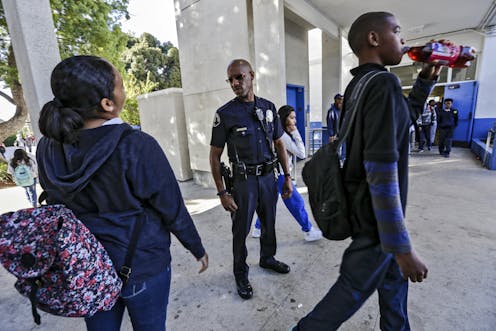Why getting back to 'normal' doesn't have to involve police in schools
- Written by Stanley S. Litow, Visting Professor of the Pratice, Public Policy, Duke University

Since COVID-19 forced many of America’s schools to teach kids remotely, parents and elected officials have been rightly concerned about when things will get back to normal.
But there are certain aspects of education where a return to a prepandemic “normal” may not be in the best interests of America’s students.
I believe that stationing large numbers of police officers inside public schools is one reality ripe for reform. I say this not only as a scholar of the politics of education[1], but as former deputy chancellor of New York City’s public schools. I served right before New York City’s mayor at the time – Rudolph Giuliani – moved to have the police department take over school security[2] for the city’s school system.
A look back at that decision – and its consequences – can help inform the ongoing discussion about whether or how police belong in America’s schools.
Police takeover
Upon becoming mayor in 1994, Giuliani moved forward with the extraordinary step of shifting the responsibility for school discipline to the New York City Police Department[3], which he ultimately got the then-independent[4] Board of Education to approve in 1998[5].
Giuliani wanted schools to have a more visible police presence[6], even though there was evidence that violence in the city’s schools was rare[7].
As the city’s deputy schools chancellor in the early 1990s, I opposed this move, as did then-Chancellor of Schools Ramón Cortines[8], and his successor, Rudy Crew[9]. We all expressed concerns that it would not make schools safer, but would negatively affect the entire school climate and impede educational progress.
At the time, when the Division of School Safety reported to me, it had roughly 2,900 school safety officers[10] – none of whom were police officers – and a budget of about US$72 million[11]. By 2020 under New York City’s police force, staffing for school safety officers roughly doubled in size, growing to 5,511[12].
And some budget reports now document spending growing to over $400 million[13]. But the massive spike in staffing and spending is part of a larger social justice problem known as the “school-to-prison pipeline[14],” in which exposure to the justice system takes place as a result of even minor infractions at school.
Disparities in discipline
Nationally, Black boys get suspended once or more during the school year at more than three times the rate[15] that white boys do. In one state, Indiana, Black students’ probability of being suspended or expelled in a school year is roughly 16% higher[16] than it is for white students.
Research[17] has shown that Black students are “more likely to be seen as problematic and more likely to be punished than white students are for the same offense.”
In the 2018 school year, roughly half of U.S. schools[18] had some law enforcement officials stationed in them. This is evidence that many U.S. school systems have been following a more visible form of school discipline with closer and deeper connections to policing and law enforcement than in the past.
Alternatives to police
I believe there is a different way.
School districts such as Oakland[19], California, and Denver[20], Colorado, have moved to eliminate or phase out police presence in schools.
There are plans to use the savings, at least in the case of Oakland, toward more counselors, social workers and workers who focus on restorative justice[21], which involves practices such as peer mediation, restitution and community service instead of punitive measures, such as suspension or expulsion.
The results of pilot studies in both Oakland and Denver were quite positive. In Oakland, graduation rates increased 60%[22] in schools that implemented restorative justice practices, and suspensions fell by 56%[23].
The incoming administration – through the U.S. Department of Education – has an opportunity to focus attention and resources away from having more police in schools. Instead, the administration of President-elect Joe Biden can provide funding incentives that would encourage school districts to increase school safety and school success, by investing more heavily in counselors and other forms of student support.
As I see it, by doing so, America’s schools will be safe, but also more students will graduate[24] and fewer young people will be fed into the school-to-prison pipeline.
References
- ^ scholar of the politics of education (www.stanlitow.com)
- ^ police department take over school security (www.nytimes.com)
- ^ to the New York City Police Department (www.nytimes.com)
- ^ then-independent (www.edweek.org)
- ^ approve in 1998 (www.nytimes.com)
- ^ more visible police presence (www.nytimes.com)
- ^ violence in the city’s schools was rare (www.nytimes.com)
- ^ then-Chancellor of Schools Ramón Cortines (www.nytimes.com)
- ^ Rudy Crew (www.nytimes.com)
- ^ 2,900 school safety officers (www.cdfny.org)
- ^ US$72 million (www.cdfny.org)
- ^ 5,511 (www.politico.com)
- ^ $400 million (www.cdfny.org)
- ^ school-to-prison pipeline (www.justicepolicy.org)
- ^ three times the rate (doi.org)
- ^ roughly 16% higher (doi.org)
- ^ Research (doi.org)
- ^ roughly half of U.S. schools (www.aclu.org)
- ^ Oakland (edsource.org)
- ^ Denver (coloradosun.com)
- ^ restorative justice (doi.org)
- ^ graduation rates increased 60% (www.ousd.org)
- ^ suspensions fell by 56% (www.ousd.org)
- ^ more students will graduate (www.civilrightsproject.ucla.edu)
Authors: Stanley S. Litow, Visting Professor of the Pratice, Public Policy, Duke University

